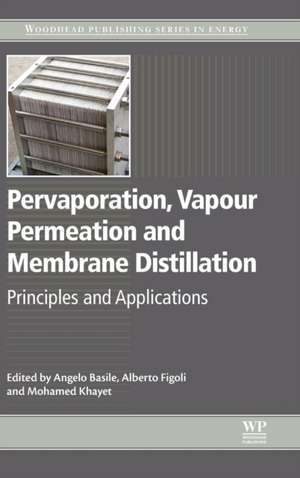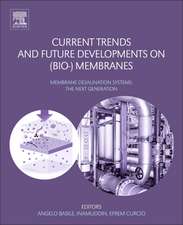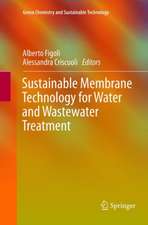Pervaporation, Vapour Permeation and Membrane Distillation: Principles and Applications: Woodhead Publishing Series in Energy
Autor Angelo Basile, Alberto Figoli, Mohamed Khayeten Limba Engleză Hardback – 19 feb 2015
Part One begins by covering the fundamentals, preparation and characterization of pervaporation, before going on to outline the associated systems and applications. State of the art uses, future trends and next generation pervaporation are then discussed. Part Two then explores the preparation, characterization, systems and applications of membranes for vapour permeation, followed by modelling and the new generation of vapour permeation membranes. Finally, Part Three outlines the fundamentals of membrane distillation and its applications in integrated systems, before the book concludes with a view of the next generation.
- Explores three emerging membrane technologies that produce vapour as a permeate.
- Looks at the fundamentals, applications, state of the art uses and next generation of each technology.
- Provides an authoritative guide for chemical engineers and academic researchers interested in membrane technologies for desalination, process water/steam treatment, water purification, VOCs removal and other aspects of pollution control, industrial process chemistry, renewable energy production or separation and concentration in the food/pharmaceutical industries.
Din seria Woodhead Publishing Series in Energy
-
 Preț: 853.23 lei
Preț: 853.23 lei - 24%
 Preț: 1209.19 lei
Preț: 1209.19 lei - 24%
 Preț: 1307.96 lei
Preț: 1307.96 lei - 24%
 Preț: 1386.95 lei
Preț: 1386.95 lei - 9%
 Preț: 900.25 lei
Preț: 900.25 lei - 9%
 Preț: 1067.83 lei
Preț: 1067.83 lei - 29%
 Preț: 1071.46 lei
Preț: 1071.46 lei - 9%
 Preț: 950.40 lei
Preț: 950.40 lei - 9%
 Preț: 1011.50 lei
Preț: 1011.50 lei - 29%
 Preț: 1071.13 lei
Preț: 1071.13 lei - 9%
 Preț: 1309.35 lei
Preț: 1309.35 lei - 39%
 Preț: 1047.65 lei
Preț: 1047.65 lei - 9%
 Preț: 949.23 lei
Preț: 949.23 lei - 24%
 Preț: 1688.64 lei
Preț: 1688.64 lei - 9%
 Preț: 1344.70 lei
Preț: 1344.70 lei - 9%
 Preț: 1049.56 lei
Preț: 1049.56 lei - 27%
 Preț: 1937.44 lei
Preț: 1937.44 lei - 23%
 Preț: 1519.01 lei
Preț: 1519.01 lei - 23%
 Preț: 1074.68 lei
Preț: 1074.68 lei - 29%
 Preț: 981.24 lei
Preț: 981.24 lei - 9%
 Preț: 1397.24 lei
Preț: 1397.24 lei - 39%
 Preț: 1397.48 lei
Preț: 1397.48 lei - 9%
 Preț: 945.89 lei
Preț: 945.89 lei - 9%
 Preț: 1073.87 lei
Preț: 1073.87 lei - 9%
 Preț: 1514.09 lei
Preț: 1514.09 lei - 9%
 Preț: 1020.23 lei
Preț: 1020.23 lei - 39%
 Preț: 880.81 lei
Preț: 880.81 lei - 9%
 Preț: 950.94 lei
Preț: 950.94 lei - 39%
 Preț: 1225.96 lei
Preț: 1225.96 lei - 9%
 Preț: 1214.08 lei
Preț: 1214.08 lei - 39%
 Preț: 1085.98 lei
Preț: 1085.98 lei - 9%
 Preț: 868.43 lei
Preț: 868.43 lei - 24%
 Preț: 1615.93 lei
Preț: 1615.93 lei - 31%
 Preț: 927.68 lei
Preț: 927.68 lei - 24%
 Preț: 1077.86 lei
Preț: 1077.86 lei - 9%
 Preț: 946.04 lei
Preț: 946.04 lei - 9%
 Preț: 952.05 lei
Preț: 952.05 lei - 9%
 Preț: 1165.33 lei
Preț: 1165.33 lei - 24%
 Preț: 1307.96 lei
Preț: 1307.96 lei - 29%
 Preț: 1213.47 lei
Preț: 1213.47 lei - 24%
 Preț: 1075.25 lei
Preț: 1075.25 lei - 24%
 Preț: 1048.44 lei
Preț: 1048.44 lei - 29%
 Preț: 1454.22 lei
Preț: 1454.22 lei - 39%
 Preț: 1285.27 lei
Preț: 1285.27 lei - 9%
 Preț: 952.68 lei
Preț: 952.68 lei - 23%
 Preț: 878.04 lei
Preț: 878.04 lei - 9%
 Preț: 1209.42 lei
Preț: 1209.42 lei - 9%
 Preț: 1233.82 lei
Preț: 1233.82 lei
Preț: 951.98 lei
Preț vechi: 1046.14 lei
-9% Nou
Puncte Express: 1428
Preț estimativ în valută:
182.19€ • 189.50$ • 150.40£
182.19€ • 189.50$ • 150.40£
Carte tipărită la comandă
Livrare economică 08-22 aprilie
Preluare comenzi: 021 569.72.76
Specificații
ISBN-13: 9781782422464
ISBN-10: 1782422463
Pagini: 480
Dimensiuni: 152 x 229 x 26 mm
Greutate: 0.87 kg
Editura: ELSEVIER SCIENCE
Seria Woodhead Publishing Series in Energy
ISBN-10: 1782422463
Pagini: 480
Dimensiuni: 152 x 229 x 26 mm
Greutate: 0.87 kg
Editura: ELSEVIER SCIENCE
Seria Woodhead Publishing Series in Energy
Cuprins
- Related titles
- List of contributors
- Woodhead Publishing Series in Energy
- Preface
- Part One. Pervaporation
- 1. Fundamentals of pervaporation
- 1.1. Introduction
- 1.2. Fundamentals of mass and heat transfer in pervaporation
- 1.3. Process and technological matters in pervaporation
- 1.4. Concluding remarks and future trends
- 2. Pervaporation membranes: preparation, characterization, and application
- 2.1. Introduction
- 2.2. Pervaporation (PV) membrane materials
- 2.3. Characterization of pervaporation membranes
- 2.4. Membrane module configurations for pervaporation
- 2.5. Membranes for pervaporation applications
- 2.6. Future trends and conclusions
- 3. Integrated systems involving pervaporation and applications
- 3.1. Introduction to integrated systems involving pervaporation
- 3.2. Applications of integrated systems involving pervaporation
- 3.3. Conclusions and future trends
- 3.4. Sources of further information and advice
- 4. Pervaporation modeling: state of the art and future trends
- 4.1. Introduction
- 4.2. Fundamentals of pervaporation modeling
- 4.3. Applications to improve the efficiency of pervaporation
- 4.4. Conclusions
- 4.5. Future trends
- 4.6. Sources of further information and advice
- 5. Next-generation pervaporation membranes: recent trends, challenges and perspectives
- 5.1. Introduction
- 5.2. Modified ceramic membranes
- 5.3. Mixed matrix membranes
- 5.4. Bio-inspired membranes and membrane synthesis approaches
- 5.5. Supported liquid (SL) membranes
- 5.6. Final remarks and future trends
- 5.7. Sources of further information
- 1. Fundamentals of pervaporation
- Part Two. Vapour permeation
- 6. Membranes for vapour permeation: preparation and characterization
- 6.1. Introduction
- 6.2. Polymer membranes
- 6.3. Zeolite membranes
- 6.4. Mixed matrix membranes
- 6.5. Future directions
- 7. Integrated systems involving membrane vapor permeation and applications
- 7.1. Introduction
- 7.2. Integrated systems involving membrane vapor separation
- 7.3. Applications of membrane vapor separation
- 7.4. Conclusion and sources of further information and advice
- 7.5. Future trends in development of membrane vapor separation
- 8. Vapour permeation modelling
- 8.1. Introduction
- 8.2. Fundamentals of vapour permeation modelling into dense polymeric membranes
- 8.3. Diffusion modelling
- 8.4. Solubility modelling
- 8.5. Vapour permeation in mixed matrix membranes and heterogeneous systems
- 8.6. Future trends
- 8.7. Conclusions
- 9. New generation vapour permeation membranes
- 9.1. Introduction
- 9.2. Current limitations of vapour permeation (VP)
- 9.3. Emerging VP membrane materials
- 9.4. Emerging membrane module configurations
- 9.5. Emerging applications for VP
- 9.6. Conclusions and future trends
- 9.7. Sources of further information
- 6. Membranes for vapour permeation: preparation and characterization
- Part Three. Membrane distillation
- 10. Fundamentals of membrane distillation
- 10.1. Introduction: nonisothermal membrane processes
- 10.2. Key characteristics of membrane distillation
- 10.3. Types of membranes and membrane module configurations for membrane distillation
- 10.4. Membrane distillation theory
- 10.5. Typical application of membrane distillation technology
- 10.6. Conclusions
- 10.7. Future trends and sources of further information and advice
- 11. Membranes used in membrane distillation: preparation and characterization
- 11.1. Introduction
- 11.2. Materials for membrane distillation (MD) membranes
- 11.3. Design and fabrication of MD membranes
- 11.4. Characterization of MD membranes
- 11.5. MD membrane modules and testing of MD membranes
- 11.6. Conclusions and future trends
- 11.7. Sources of further information and advice
- 12. Integrated systems involving membrane distillation and applications
- 12.1. Introduction
- 12.2. Applications of membrane distillation in desalination
- 12.3. Other applications of membrane distillation
- 12.4. Integrated systems involving membrane distillation
- 12.5. Conclusions and future trends
- 12.6. Sources of further information
- 13. Modelling of pore wetting in membrane distillation compared with pervaporation
- 13.1. Introduction
- 13.2. Fundamentals of membrane distillation (MD) modelling and improvement
- 13.3. Review of experimental works on MD membrane pore wetting
- 13.4. Development of a theoretical model for pore wetting in vacuum MD
- 13.5. Conclusions and future directions
- 14. Next generation membranes for membrane distillation and future prospects
- 14.1. Introduction
- 14.2. Materials for membrane distillation
- 14.3. Emerging module configurations for membrane distillation
- 14.4. Conclusions and future trends
- 10. Fundamentals of membrane distillation
- Index




















